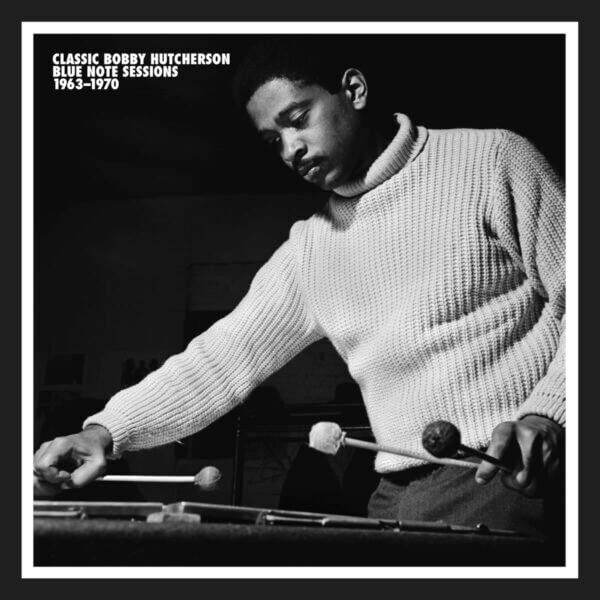The Penguin Guide to Jazz on CD (6th edition), introduces vibraphonist Bobby Hutcherson by pointing out that if he “were a saxophonist, trumpeter, or pianist, he would be regarded as a major figure in modern jazz.” That’s no exaggeration, Hutcherson (who died in 2016) was one of the greatest of all jazz musicians of the post-1959 era. He was an extraordinary musical player, whether inside an ensemble or soloing, and might have had the greatest aesthetic range of anyone. The evidence is in his discography—he is central to Eric Dolphy’s Out to Lunch!, Grant Green’s Idle Moments, Andrew Hill’s Judgment!, Dexter Gordon’s Gettin’ Around, Jackie McLean’s One Step Beyond, and Tony William’s Life Time (all on Blue Note). He played with Gerald Wilson’s mainstream big band, Archie Shepp’s “New Thing” group; hard bop with Lee Morgan, funk with Donald Byrd, soul with Lou Rawls, organ groove with John Patton, and free music with Pharoah Sanders.
That’s quite a curriculum vitae, and if it’s somehow not enough to establish him as essential to the core of modern jazz, especially in the ‘60s, than the new box set from Mosaic Records, Classic Bobby Hutcherson Blue Note Sessions 1963-1970 absolutely will. This is the last set produced by recently departed Michael Cuscuna and is one of the great triumphs of the label. The ultimate goal of archival collections like this is to reveal something important that previously had been hidden to all but the deepest cognoscenti, and that’s what this set does.
But first, what is it about the vibraphone that has players like Hutcherson so neglected? There have been famous vibraphonists in jazz history, of course; Lionel Hampton, Milt Jackson, and Gary Burton to name a few. The contemporary scene has Joel Ross and Sasha Berliner following their paths and those of Steve Nelson and Stefon Harris. And you can follow the development of modern jazz just by digging the vibes—Hampton playing with Benny Goodman, Jackson with Charlie Parker and then with John Lewis (also ex-Parker) in the Modern Jazz Quartet, Hutcherson’s modal hard bop and free playing, Gary Burton’s post-bop and modernism (and he employed Pat Metheny), the incorporation of funk and soul and rock via Nelson and Harris, out the other side in the synthesis of musics in the styles of Ross and Berliner.
But there’s a facelessness to the instrument that can leave the player anonymous. Saxophonists and trumpeters and singers can create their own immediately identifiable sounds and timbres, pianists have a broad ability to apply different kinds of touch to the keys and with ten or more notes available at once can create personal harmonic styles. But the metal bars of the vibraphone sound the same no matter who is playing them, there’s only so much variation in materials for the heads of the sticks the players use, and as a practical matter you can’t really play more than four notes simultaneously on the instrument.
That leaves the subtle details of musicianship to differentiate vibraphonists, and you have to listen past the instrument to hear them. Distinctions of timing, dynamics, the shape and placement of phrases, rhythmic sense, and of course the expression and articulation of improvised solos are the signifiers and marks of musical skill. Hampton’s swing and the verve of his attack was unmistakable, the same for Jackson’s sightly understated long legato lines and Burton’s way of playing on top of the beat and carving space around each note, no matter the velocity.
Hutcherson had bits of all of these qualities, and most of all a subtlety and musical modesty that is probably the main reason he’s not seen as a major figure. As a sideman, he could be expected to lay out through stretches of tunes, as a leader it’s startling to hear how silent he is for substantial amounts of time. He seems to be focused primarily on the overall ensemble, and it works because the albums he made for Blue Note in this period are never less than outstanding, and a couple can make a claim to being among the finest of the decade.
First chronologically is The Kicker, which features tenor saxophonist Joe Henderson at his brawny, intelligent best (and should not be confused with Henderson’s later album of the same name on Milestone). This is one of the best modern hard bop album of the ’60s. It was recorded in 1963 but only first issued under Cuscuna in 1999(!), which seems to be a measure of how undervalued Hutcherson was, even by Blue Note. With Henderson, Green, pianist Duke Pearson, bassist Bon Cranshaw, and drummer Al Harewood, the rhythms are sharp and punchy, there’s tremendous suavity, and the harmonic conception brings together both the blues and modal ideas. It is the ne plus ultra of the Blue Note sound.
Several of these albums—Dialogue, with saxophonist Sam Rivers and trumpeter Freddie Hubbard, another of the most stylistically capacious musicians of the ‘60s; Components, with James Spaulding at his very best on reeds and pianist Herbie Hancock; and Stick-Up! with Henderson again and McCoy Tyner showing more range at the piano that heard with John Coltrane—are relatively well known and have always been highly regarded. Happenings, which pairs Hancock with Hutcherson, Cranshaw again on bass and drummer Joe Chambers, is percussion heavy, inventive, and fascinating, both tangential and earthy.
What these albums do, along with Oblique and Patterns, is establish an unusual and important subformula within the larger Blue Note album approach. Rather than three up-tempo tunes and two ballads, instead there are several grooving, often structurally complex charts that feature invigorating playing, and then one or two abstract tracks, heavy on free improvisation. The albums make an important statement about the directions of jazz during the decade, how developing structures and freedom can be integrated, how musicians don’t have to choose, how jazz can be all and more. Almost no one was doing this, maybe Shepp was close, but not in a way that centered both the mainstream and the avant-garde.
On top of this, the music is stylish, soulful, smart, swinging. Hutcherson plays with clarity and purpose while always integrating his soloing with the ensemble, like a great individual athlete who also values teamwork. He’s never the main focus of the albums until the final sequence of records he made with saxophonist/flutist Harold Land in his band as co-leader. Those four, from 1968 to 1970 are Total Eclipse, Spiral, Medina, and San Francisco, and are the summit of this decade (one album, Now! is missing from here, Mosaic explains in the booklet that because it featured vocals it didn’t fit with the rest). Land is another undervalued musician, and his playing here is fantastic and should be ear-opening.
These albums are not conceptual statements, they are all about the playing. The music often includes odd-numbered meters and world music touches, and is a statement for what was happening—and possible—in mainstream modern jazz at the end of the decade. The musicians had heard freedom, rock, and soul, and there is seasoning of other music, but this is jazz through and through, with the extended bop riffs and modality of “Herzog,” the down-home soul and mellow theme of “Goin’ Down South,” the modernist blues of Chick Corea’s “Matrix”—Corea plays piano on Total Eclipse, later replaced by Stanley Cowell and Joe Sample.
Most of these albums have been in print at one time or another, briefly, but never all at once (nor are they well-collated on streaming services, and San Francisco seems to be missing altogether), meaning that those interested in Hutcherson can now hear all this music all the way through, finally. What one hears is one of the most substantial jazz discographies of the ‘60s, and one of the most unique, from one of the great masters of the music.
Author
-

George Grella wrote the book on Miles Davis’ Bitches Brew. He write other stuff too. killyridols.substack.com/
View all posts
George Grella wrote the book on Miles Davis’ Bitches Brew. He write other stuff too. killyridols.substack.com/










